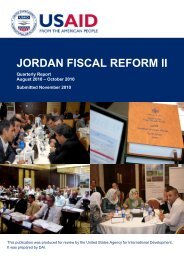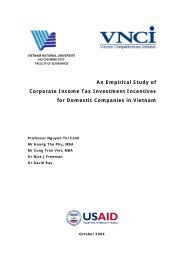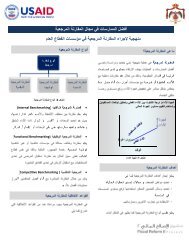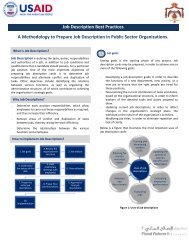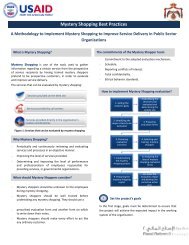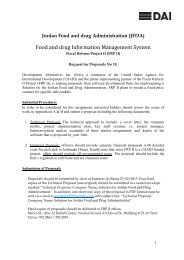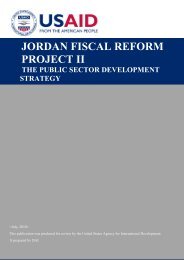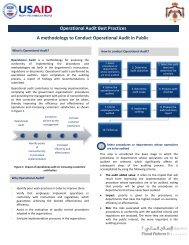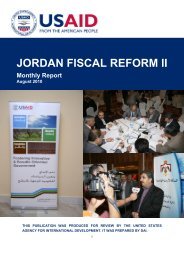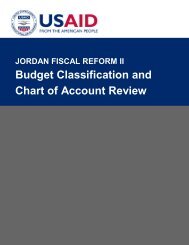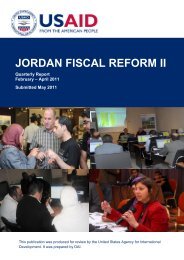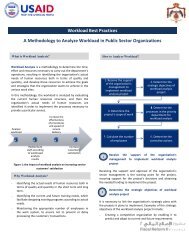Integrated Financial Management Information Systems: A ... - Frp2.org
Integrated Financial Management Information Systems: A ... - Frp2.org
Integrated Financial Management Information Systems: A ... - Frp2.org
You also want an ePaper? Increase the reach of your titles
YUMPU automatically turns print PDFs into web optimized ePapers that Google loves.
minister is replaced. If the CoA is not designed with the flexibility to accommodate these types of<br />
changes, then the IFMIS will almost certainly be thrown into disarray.<br />
CHANGE MANAGEMENT<br />
Change management is one of the most critical, but also one of the most neglected, aspects of IFMIS<br />
reforms. Despite the obvious advantages of a new IFMIS system, opposition is to be expected.<br />
Resistance will come from all angles. There will be vested interests who have benefited from the way<br />
things have traditionally been done. There will be civil servants who see new systems as a threat to<br />
their jobs. There will be those who resist simply for fear of the unknown. While opposition is not<br />
always easy to overcome, any systems implementation that ignores change management tempts<br />
failure.<br />
So what can be done? As soon as an IFMIS project is conceived, a change management strategy<br />
needs to be laid out, taking into consideration the change implications for diverse stakeholders, from<br />
politicians and senior managers to department heads, civil servants and the IT personnel who will<br />
support the new systems. A core team needs to be designated to manage the change, composed of<br />
people who can and are empowered to lead. This requires a strategy, a plan, with alternatives, with an<br />
aim to bring about the change. Overcoming resistance will happen through clear communication,<br />
education, training, and “quick wins” that demonstrate the benefits of change.<br />
This topic is worth a major examination in itself, and this paper does not pretend to delve deeply into<br />
the subject, only to introduce it to make the reader aware that change management must not be<br />
overlooked when planning or implementing an IFMIS project.<br />
CENTRALIZED TREASURY MANAGEMENT: THE TREASURY SINGLE ACCOUNT<br />
Governments need to ensure both efficient implementation of their budgets and good control over<br />
their financial resources. Spending agencies must be provided with the funds needed to implement the<br />
budget in a timely manner, and the cost of government borrowing must be minimized. Sound<br />
management of financial assets and liabilities is also required. This is generally the role of the<br />
treasury operations.<br />
Box 3. Centralized treasury management in the commercial world<br />
In the early 1980s it was already common practice for major corporations to group all financial resources into<br />
one treasury management structure. A good example at the time was Reynolds Aluminum, which placed its<br />
global treasury operations in Geneva, Switzerland. The treasury unit was staffed with only 11 people, for an<br />
organization that employed tens of thousands with hundreds of business units worldwide.<br />
The Reynolds Treasury managed all of the company’s monetary resources. Resources included not only all cash<br />
moneys but also all debt and negotiable paper. By company policy, no business unit anywhere in the world was<br />
allowed to hold any cash balances in its bank account. Instead, the Geneva Treasury transferred funds to each<br />
unit’s local bank account to meet the reported payment schedules. Any manager found to have residual cash in<br />
his unit’s bank account for more than seven working days was subject to dismissal (to the author’s knowledge,<br />
such action was only taken on two occasions).<br />
The results produced by the system were extraordinary. Reynolds’ treasury unit in Geneva regularly made more<br />
profit than the rest of the company. The management of the treasury was extremely prudent, focusing on risk<br />
limitation and minimizing the cost of financing. Yet, while applying very conservative money management<br />
techniques substantial sums of money were generated for the group from its own resources.<br />
10 INTEGRATED FINANCIAL MANAGEMENT INFORMATION SYSTEMS: A PRACTICAL GUIDE



